NCERT Solutions Class 6 Maths
Chapter – 3 (Playing with Numbers)
The NCERT Solutions in English Language for Class 6 Mathematics Chapter – 3 Playing with Numbers Exercise 3.7 has been provided here to help the students in solving the questions from this exercise.
Chapter 3: Playing with Numbers
- NCERT Solution Class 6 Maths Exercise – 3.1
- NCERT Solution Class 6 Maths Exercise – 3.2
- NCERT Solution Class 6 Maths Exercise – 3.3
- NCERT Solution Class 6 Maths Exercise – 3.4
- NCERT Solution Class 6 Maths Exercise – 3.5
- NCERT Solution Class 6 Maths Exercise – 3.6
Exercise – 3.7
1. Renu purchases two bags of fertiliser of weights 75 kg and 69 kg. Find the maximum value of weight which can measure the weight of the fertiliser exact number of times.
Solutions:
Given, weight of two bags of fertiliser = 75 kg and 69 kg
Maximum weight = HCF of two bags weight i.e (75, 69)
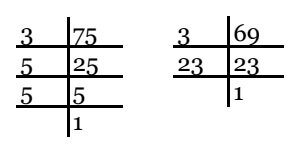
75 = 3 × 5 × 5
69 = 3 × 23
HCF = 3
Hence, 3 kg is the maximum value of weight which can measure the weight of the fertiliser exact number of times.
2. Three boys step off together from the same spot. Their steps measure 63 cm, 70 cm and 77 cm respectively. What is the minimum distance each should cover so that all can cover the distance in complete steps?
Solutions:
First boy steps measure = 63 cm
Second boy steps measure = 70 cm
Third boy steps measure = 77 cm
LCM of 63, 70, 77
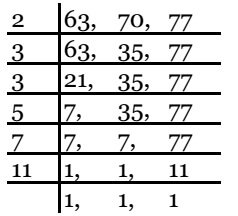
LCM = 2 × 3 × 3 × 5 × 7 × 11 = 6930
Hence, 6930 cm is the distance each should cover so that all can cover the distance in complete steps.
3. The length, breadth and height of a room are 825 cm, 675 cm and 450 cm respectively. Find the longest tape which can measure the three dimensions of the room exactly.
Solutions:
Given length of a room = 825 cm
Breadth of a room = 675 cm
Height of a room = 450 cm
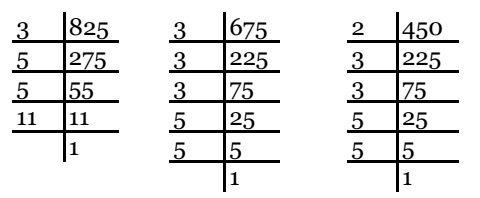
825 = 3 × 5 × 5 × 11
675 = 3 × 3 × 3 × 5 × 5
450 = 2 × 3 × 3 × 5 × 5
HCF = 3 × 5 × 5 = 75 cm
Hence longest tape is 75 cm which can measure the three dimensions of the room exactly.
4. Determine the smallest 3-digit number which is exactly divisible by 6, 8 and 12.
Solutions:
LCM of 6, 8, 12 = smallest number
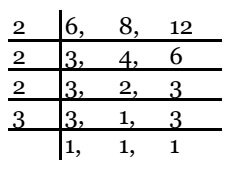
LCM = 2 × 2 × 2 × 3 = 24
Now we need to find the smallest 3-digit multiple of 24
We know that 24 × 4 = 96 and 24 × 5 = 120
Hence, 120 is the smallest 3-digit number which is exactly divisible by 6, 8 and 12
5. Determine the greatest 3-digit number exactly divisible by 8, 10 and 12.
Solutions:
LCM of 8, 10 and 12
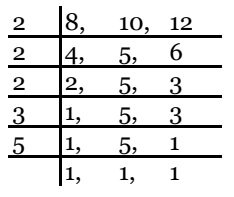
LCM = 2 × 2 × 2 × 3 × 5 = 120
Now we need to find the greatest 3-digit multiple of 120
We may find 120 × 8 = 960 and 120 × 9 = 1080
Hence, 960 is the greatest 3-digit number exactly divisible by 8, 10 and 12
6. The traffic lights at three different road crossings change after every 48 seconds, 72 seconds and 108 seconds respectively. If they change simultaneously at 7 a.m., at what time will they change simultaneously again?
Solutions:
LCM of 48, 72, 108 = time period after which these lights change
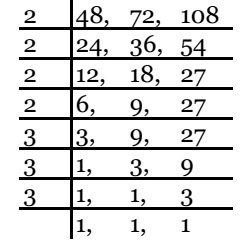
LCM = 2 × 2 × 2 × 2 × 3 × 3 × 3 = 432
Hence, lights will change together after every 432 seconds
Therefore the lights will change simultaneously at 7 minutes 12 seconds.
7. Three tankers contain 403 litres, 434 litres and 465 litres of diesel respectively. Find the maximum capacity of a container that can measure the diesel of the three containers exact number of times.
Solutions:
HCF of 403, 434, 465 = Maximum capacity of tanker required
403 = 13 × 31
434 = 2 × 7 × 31
465 = 3 × 5 × 31
HCF = 31
Hence, a container of 31 litres can measure the diesel of the three containers exact number of times.
8. Find the least number which when divided by 6, 15 and 18 leave remainder 5 in each case.
Solutions:
LCM of 6, 15, 18
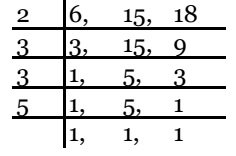
LCM = 2 × 3 × 3 × 5 = 90
Required number = 90 + 5 = 95
Hence, 95 is the required number.
9. Find the smallest 4-digit number which is divisible by 18, 24 and 32.
Solutions:
LCM of 18, 24, 32
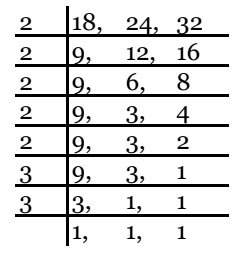
LCM = 2 × 2 × 2 × 2 × 2 × 3 × 3 = 288
Here, we need to find the smallest 4-digit multiple of 288
We find 288 × 3 = 864 and 288 × 4 = 1152
Hence, 1152 is the smallest 4-digit number which is divisible by 18, 24 and 32
10. Find the LCM of the following numbers:
(a) 9 and 4
(b) 12 and 5
(c) 6 and 5
(d) 15 and 4
Observe a common property in the obtained LCMs. Is LCM the product of two numbers in each case?
Solutions:
(a) LCM of 9, 4
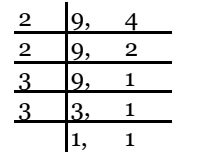
LCM = 2 × 2 × 3 × 3 = 36
(b) LCM of 12, 5
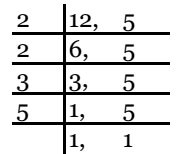
LCM = 2 × 2 × 3 × 5 = 60
(c) LCM of 6, 5
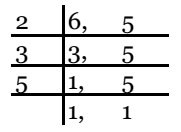
LCM = 2 × 3 × 5 = 30
(d) LCM of 15, 4
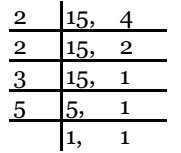
LCM = 2 × 2 × 3 × 5 = 60
Yes in each case the LCM of given numbers is the product of these numbers.
11. Find the LCM of the following numbers in which one number is the factor of the other.
(a) 5, 20
(b) 6, 18
(c) 12, 48
(d) 9, 45
What do you observe in the results obtained?
Solutions:
(a) 5, 20
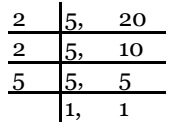
LCM = 2 × 2 × 5 = 20
(b) 6, 18
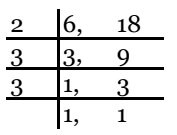
LCM = 2 × 3 × 3 = 18
(c) 12, 48
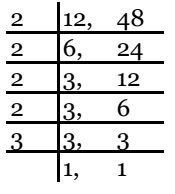
LCM = 2 × 2 × 2 × 2 × 3 = 48
(d) 9, 45
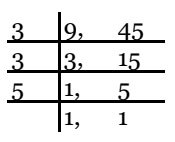
LCM = 3 × 3 × 5 = 45
∴ Hence, in each case the LCM of given numbers is the larger number. When a number is a factor of other number then their LCM will be the larger number.

